Demand for nuts as snacks and ingredients in the United States is estimated at USD 9.17 billion in 2025, with projections indicating a rise to USD 12.20 billion by 2035, reflecting a CAGR of approximately 2.9% over the forecast period. This growth reflects both a broadening consumer base and increased per capita consumption in key urban centers.
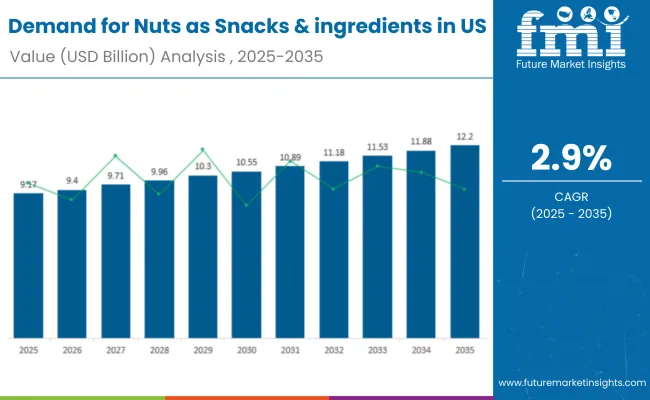
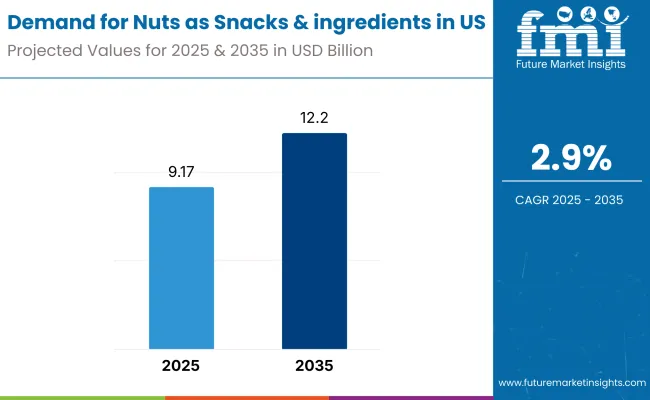
The rise in demand is linked to shifting dietary preferences, growing awareness of health benefits, and evolving snacking trends. By 2025, per capita consumption in leading USA states such as California, Texas, and Florida averages between 2.8 to 3.2 kilograms, with projections reaching 3.5 kilograms by 2035. California leads among states, expected to generate USD 1.39 billion in nut demand by 2035, followed by Texas (USD 1.04 billion), Florida (USD 0.75 billion), New York (USD 0.69 billion), and Pennsylvania (USD 0.46 billion).
The largest contribution to demand continues to come from direct-to-consumer snacking applications, which are expected to account for 47% of total sales in 2035, owing to strong shelf presence, convenience packaging, and consumer preference for healthy snacking alternatives. By distribution channel, supermarkets represent the dominant retail format, responsible for 52% of all sales, while online retail platforms are expanding rapidly.
Consumer adoption is particularly concentrated among health-conscious millennials and busy professionals, with income and urban density emerging as significant drivers of demand. While premium organic varieties command higher prices, the average price premium over conventional nuts has stabilized around 15-20% in 2025.
Continued improvements in supply chain efficiency and private label offerings are expected to accelerate affordability and access across mid-income households. Regional disparities persist, but per capita demand in high-growth Sun Belt states is narrowing the gap with traditionally strong coastal consumption hubs.
The nuts as snacks and ingredients segment in the USA is classified across several segments. By application, the key categories include direct-to-consumer snacks, ingredient and foodservice applications, bakery and confectionery uses, and dairy alternatives. By distribution channel, the segment spans supermarkets and hypermarkets, convenience and specialty stores, online retail platforms, and foodservice and industrial channels. By nut type, formulations include almonds, peanuts, cashews, walnuts, pistachios, and mixed varieties. By nature, the segment covers raw nuts, roasted and flavored varieties, salted options, organic certified products, and conventional processing. By region, states such as California, Texas, Florida, New York, and Pennsylvania are included, along with coverage across all 50 states.
Direct-to-consumer snacking applications are projected to dominate demand in 2035, supported by portable packaging, health positioning, and category familiarity. Other applications such as ingredients, bakery uses, and dairy alternatives serve distinct consumption needs.
Nuts as snacks and ingredients in the USA. are distributed through a mix of mainstream retail and alternative sales channels. Supermarkets are expected to remain the primary point of sale in 2035, followed by convenience stores and online retail. Distribution strategies are evolving to match consumer shopping behavior, with growth coming from both physical and digital formats.
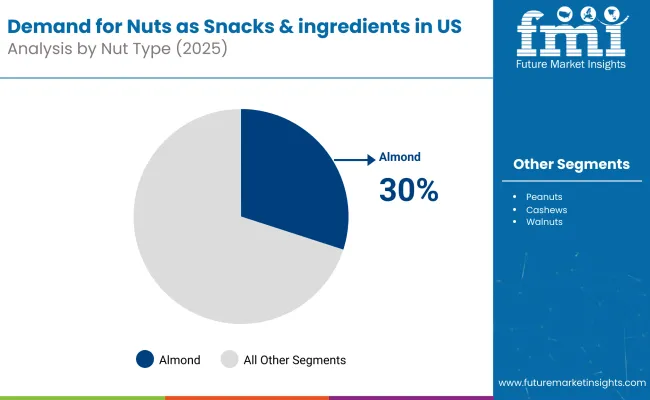
Nuts as snacks and ingredients in the USA utilize a variety of nut types, selected for taste profile, nutritional content, shelf stability, and processing versatility. Almonds remain the most widely consumed nut, though peanuts and cashews maintain strong positions across different consumer segments.
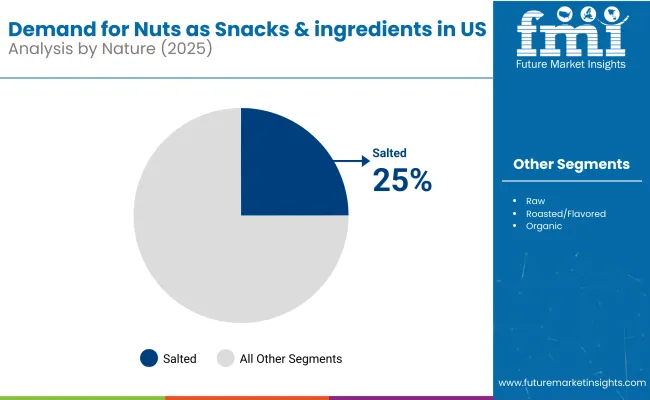
The nuts category appeals to diverse taste preferences and health priorities across processing methods. Roasted and flavored options dominate consumer preference, while raw and organic segments serve specific dietary and lifestyle needs.
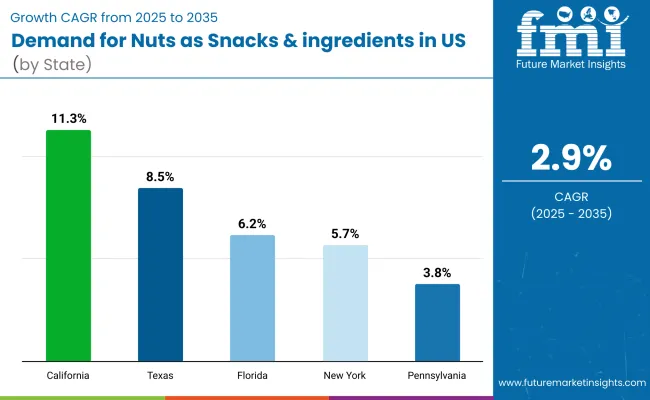
Nuts demand will not grow uniformly across every state. Rising population inflows and established consumption patterns in traditional nut-producing regions give California and Texas measurable advantages, while emerging consumption states expand more modestly from smaller bases. The table below shows the compound annual growth rate (CAGR) each of the five largest states is expected to record between 2025 and 2035.
Between 2025 and 2035, demand for nuts as snacks and ingredients is projected to expand across all major USA states, with growth rates clustering around the national average of 2.9%. California is expected to register the fastest compound annual growth rate (CAGR) of 2.95%, maintaining its position as the dominant consumption state while benefiting from both local production advantages and diverse demographic growth. The state's leadership reflects established almond and walnut growing regions, health-conscious consumer base, and extensive retail distribution networks spanning urban and suburban markets.
Texas follows closely with a CAGR of 2.90%, driven by population growth, expanding Hispanic consumer segments with strong nut consumption traditions, and increasing retail penetration across major metropolitan areas including Houston, Dallas, and Austin. Per capita consumption in Texas is projected to rise from 2.8 kg in 2025 to 3.2 kg by 2035, supported by growing awareness of nuts as convenient protein sources.
New York maintains steady growth at 2.89% CAGR, reflecting mature consumption patterns and premium product adoption in urban markets. The state benefits from established retail infrastructure and consumer willingness to pay premium prices for organic and specialty nut varieties.
Florida and Pennsylvania show slightly more moderate growth at 2.87% and 2.88% respectively, with Florida benefiting from retiree populations focused on heart-healthy snacking, while Pennsylvania maintains consistent demand across both urban centers and rural markets with established snacking traditions.
.webp)
The competitive environment is characterized by a mix of agricultural cooperatives, established snack food manufacturers, and emerging health-focused brands. Distribution breadth and supply chain control remain decisive success factors: the five largest suppliers collectively reach more than 40,000 retail outlets nationwide and account for a majority of shelf facings across snack and baking aisles.
Blue Diamond Growers, as a cooperative of California almond farmers, maintains the strongest position in almond-based products with over 200 SKUs spanning raw, roasted, flavored, and ingredient applications. Its vertical integration from farming through processing gives it cost advantages and quality control, while brand recognition supports premium positioning in retail channels.
Wonderful Pistachios, part of The Wonderful Company, leverages integrated farming and processing operations to control pistachio supply chains from orchard to package. Post-harvest investments in processing technology have enabled flavored varieties and portion-controlled packaging that commands premium pricing compared to commodity nuts.
Planters, owned by Hormel Foods since 2021, benefits from established distribution relationships and iconic brand recognition spanning multiple nut categories. Recent launches focus on protein positioning and clean-label reformulations targeting health-conscious consumers while maintaining accessibility through mass retail channels.
Kind Snacks, acquired by Mars in 2020, represents the premium healthy snacking segment with nut-based bars and clusters that command significant price premiums. The brand's success in positioning nuts as wholesome ingredients rather than indulgent snacks has influenced category marketing across multiple competitors.
Emerging players include Sahale Snacks with globally-inspired flavor profiles, and numerous private label programs at Costco (Kirkland), Kroger (Simple Truth), and Target (Good & Gather) offering comparable quality at 15-20% price discounts. Consolidation continues as retail concentration increases buyer power and operational scale becomes critical for maintaining distribution access.
| Attribute | Details |
|---|---|
| Study Coverage | USA demand and consumption of nuts as snacks and ingredients from 2020 to 2035 |
| Base Year | 2025 |
| Historical Data | 2020 |
| Forecast Period | 2025 to 2035 |
| Units of Measurement | USD (sales), Metric Tonnes (volume), Kilograms per capita (consumption) |
| Geography Covered | All 50 USA states; state-level analysis |
| Top States Analyzed | California, Texas, Florida, New York, Pennsylvania |
| By Application | Snacks, Ingredient/Foodservice, Bakery & Confectionery, Dairy Alternatives |
| By Distribution Channel | Supermarkets/Hypermarkets, Convenience/Specialty, Online/E-commerce, Foodservice/Industrial |
| By Nut Type | Almonds, Peanuts, Cashews, Walnuts, Pistachios, Mixed/Others |
| By Nature | Raw, Roasted/Flavored, Salted, Organic, Conventional |
| Metrics Provided | Sales (USD), Volume (MT), Per capita consumption (kg), CAGR (2025 to 2035), Share by segment |
| Price Analysis | Average unit prices by nut type and processing method |
| Competitive Landscape | Company profiles, private label strategies, cooperative vs. corporate structures |
| Forecast Drivers | Health awareness trends, snacking behavior evolution, supply chain optimization |
By 2035, total USA demand for nuts as snacks and ingredients is projected to reach USD 12.20 billion, up from USD 9.17 billion in 2025, reflecting a CAGR of approximately 2.9%.
Direct-to-consumer snacks hold the leading share, accounting for approximately 47% of total demand in 2035, followed by ingredient and foodservice applications at 28%.
California leads in projected growth with a CAGR of 2.95% between 2025 and 2035, followed by Texas at 2.90%, due to population growth and established consumption patterns.
Supermarkets and hypermarkets are the dominant sales channel (52% share in 2035), while online retail platforms are growing rapidly to reach 17% share by 2035.
Major players include Blue Diamond Growers, Wonderful Pistachios, Planters (Hormel), Kind Snacks (Mars), and Sahale Snacks, with growing competition from private label brands like Costco's Kirkland and Kroger's Simple Truth.






Our Research Products

The "Full Research Suite" delivers actionable market intel, deep dives on markets or technologies, so clients act faster, cut risk, and unlock growth.

The Leaderboard benchmarks and ranks top vendors, classifying them as Established Leaders, Leading Challengers, or Disruptors & Challengers.

Locates where complements amplify value and substitutes erode it, forecasting net impact by horizon

We deliver granular, decision-grade intel: market sizing, 5-year forecasts, pricing, adoption, usage, revenue, and operational KPIs—plus competitor tracking, regulation, and value chains—across 60 countries broadly.

Spot the shifts before they hit your P&L. We track inflection points, adoption curves, pricing moves, and ecosystem plays to show where demand is heading, why it is changing, and what to do next across high-growth markets and disruptive tech

Real-time reads of user behavior. We track shifting priorities, perceptions of today’s and next-gen services, and provider experience, then pace how fast tech moves from trial to adoption, blending buyer, consumer, and channel inputs with social signals (#WhySwitch, #UX).

Partner with our analyst team to build a custom report designed around your business priorities. From analysing market trends to assessing competitors or crafting bespoke datasets, we tailor insights to your needs.
Supplier Intelligence
Discovery & Profiling
Capacity & Footprint
Performance & Risk
Compliance & Governance
Commercial Readiness
Who Supplies Whom
Scorecards & Shortlists
Playbooks & Docs
Category Intelligence
Definition & Scope
Demand & Use Cases
Cost Drivers
Market Structure
Supply Chain Map
Trade & Policy
Operating Norms
Deliverables
Buyer Intelligence
Account Basics
Spend & Scope
Procurement Model
Vendor Requirements
Terms & Policies
Entry Strategy
Pain Points & Triggers
Outputs
Pricing Analysis
Benchmarks
Trends
Should-Cost
Indexation
Landed Cost
Commercial Terms
Deliverables
Brand Analysis
Positioning & Value Prop
Share & Presence
Customer Evidence
Go-to-Market
Digital & Reputation
Compliance & Trust
KPIs & Gaps
Outputs
Full Research Suite comprises of:
Market outlook & trends analysis
Interviews & case studies
Strategic recommendations
Vendor profiles & capabilities analysis
5-year forecasts
8 regions and 60+ country-level data splits
Market segment data splits
12 months of continuous data updates
DELIVERED AS:
PDF EXCEL ONLINE
Demand Signal Repository Solutions Market Size and Share Forecast Outlook 2025 to 2035
Demand Side Management Market Size and Share Forecast Outlook 2025 to 2035
Demand Response Market Analysis - Size, Share, and Forecast Outlook 2025 to 2035
North America Shipping Supplies Market Trends – Innovations & Growth 2024-2034
Demand of Kozani Saffron in Greece Analysis - Size, Share & Forecast 2025 to 2035
Demand of No-acid Whey Strained Dairy Processing Concepts in European Union Size and Share Forecast Outlook 2025 to 2035
Demand for Bronte Pistachio in Italy Analysis - Size, Share & Forecast 2025 to 2035
Demand and Trend Analysis of Gaming Monitor in Western Europe Size and Share Forecast Outlook 2025 to 2035
Demand and Trend Analysis of Gaming Monitor in Japan Size and Share Forecast Outlook 2025 to 2035
Demand and Trend Analysis of Gaming Monitor in Korea Size and Share Forecast Outlook 2025 to 2035
Glycine Soja (Soybean) Seed Extract Market Size and Share Forecast Outlook 2025 to 2035
Demand and Trends Analysis of Stevia in Japan Size and Share Forecast Outlook 2025 to 2035
Japan Women’s Intimate Care Market Trends – Growth & Forecast 2024-2034
Western Europe Men’s Skincare Market Analysis – Forecast 2023-2033
Demand and Trend Analysis of Fabric Stain Remover in Korea Size and Share Forecast Outlook 2025 to 2035
Demand and Sales Analysis of Paper Cup in Japan Size and Share Forecast Outlook 2025 to 2035
Demand and Sales Analysis of Paper Cup in Korea Size and Share Forecast Outlook 2025 to 2035
Demand and Sales Analysis of Paper Cup in Western Europe Size and Share Forecast Outlook 2025 to 2035
Demand of MFGM-enriched Powders & RTDs in European Union Size and Share Forecast Outlook 2025 to 2035
Demand and Trend Analysis of Avocado Oil in Western europe Size and Share Forecast Outlook 2025 to 2035

Thank you!
You will receive an email from our Business Development Manager. Please be sure to check your SPAM/JUNK folder too.
Chat With
MaRIA